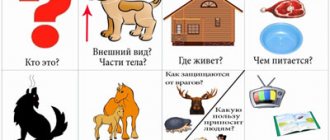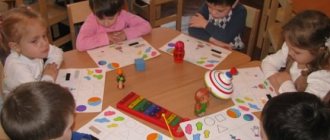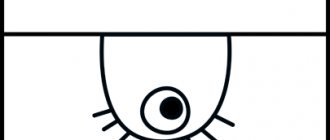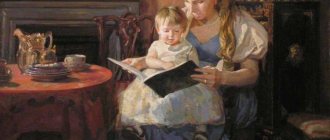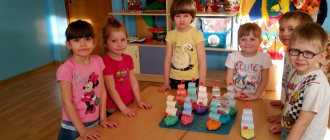Quote from the message to MY_GRANDCHILDREN_USEFUL
Read in full In your quotation book or community!
What is mnemonics and how to work with mnemonic tables for children’s development
Mnemonics helps young children:
- It is easier to remember poems, tongue twisters, riddles, stories;
- Recode information from visual to abstract and vice versa;
- Build a logical chain of events and reproduce the story in the correct order (beginning - middle - ending);
- Enriches vocabulary;
- Helps develop thinking;
- Develops imagination;
- Helps write long descriptive sentences and coordinate tenses.
This technique uses visual aids - tables. In speech development classes, teachers often use mnemonics and ask children to decipher and memorize images on tables. Tables can have a wide variety of designs and themes.
There are the following mnemonic tables:
- For poems, riddles or fairy tales;
- To remember the rules;
- For stories.
Modern children are surrounded by a mass of information; most often, they do not have time to assimilate it, and therefore have problems reproducing it. Preschool children often have a fairly large vocabulary, but they only make up simple sentences that they cannot put together into a complete logical story. Mnemonic tables teach children to plan a story and reproduce it in a logical order. The use of mnemonic tables significantly improves the educational process, children learn faster.
Books on mnemonics for children
- “Learning from a fairy tale”, T.V. Bolshakova;
- “Supermemory for everyone”, E.E. Vasilyeva, V. Yu. Vasiliev;
- “Remember everything. Practical guide to memory development”, Arthur Dumchev;
- “Brain development. How to Read Faster, Remember Better, and Achieve Bigger Goals by Roger Sipe;
- “Einstein walks on the moon. The Science and Art of Memory,” Joua Foer;
- A. R. Luria. “A little book about a big memory”;
- How to Develop Super Memory by Dominic O'Brien.
The books describe in detail common techniques, proprietary methods, give tips on mastering and demonstrate the work with examples.
Where and who will use mnemonics?
- For children - to remember information in school and kindergarten. Learning poetry with this technique is a pleasure for both children and parents.
- For students - to effectively pass the session and tests. It’s easy to repeat and remember the year’s material in a week! The main thing is to use techniques.
- For adults - at work, in making presentations, in planning things, making shopping lists and much more.
No talent or special abilities are needed to teach mnemonics. We need systematic, disciplined training. Have information you need to remember? Remember one of our exercises and put it into practice with your children.
Tips for using mnemonics
- Start with the basics. Don't try to remember large amounts of data at once. Practice on single images, short lists of words, dates. Focus on the techniques that mnemonics offers for beginners: the method of stories or visualization. Increase the difficulty gradually, noticing progress at previous stages.
- For training, choose bright images; for children, always color ones. Such illustrations attract attention better, allow you to focus on details, and highlight more associative connections.
- Don't get overwhelmed. For children, 2 mnemonic tables per lesson are enough, no more than 9 squares per piece. A large amount of data causes boredom and in the form of a game.
- Make mnemonics classes varied. Change exercises, topics, memorize texts, illustrations and numbers.
- Remember that you need to exercise regularly. Perform 1-3 exercises daily, gradually limiting the time or increasing the load.
What is mnemonics
The concept is associated with a system that helps to assimilate large amounts of information. These are exercises that help evoke associations and remember. Associations can be kinesthetic (tactile), visual (visible), auditory (auditory).
How to remember a date from history?
Imagine that this is the day and month of “your acquaintance” with a historical character. Or the day when “you visited” the site of a historical event.
Everyone can associate differently. The task of parents is to teach the child to find the association on his own based on examples and remember it. And then reproduce it in memory.
Work experience “Use of mnemonic tables in the development of speech in children of middle preschool age”
Ekaterina Stolyarova
Work experience “Use of mnemonic tables in the development of speech in children of middle preschool age”
Relevance and prospects of experience
The modern world is saturated with the latest technologies, children live in a powerful flow of information, where live communication is replaced by communication with a computer and TV, tablet or phone. Lack of communication between parents and their children and ignoring speech difficulties only increases the number of preschoolers with speech impediments . Currently, the problem of speech development is becoming especially relevant.
Conditions for the formation of experience
Many children in the middle group have slurred speech, a limited vocabulary, and some children are speechless. An analysis of the observations showed that the speech development of children is at an insufficient level of development . And I came to the conclusion that with the help of mnemonic tables it will be easier for children to master coherent speech.
Pedagogical idea
The leading idea of the experiment is the use of mnemonic tables in the development of speech in children of middle preschool age . Since mastering coherent oral speech is the most important condition for successful preparation for school.
In this regard, I set myself a goal:
formation of speech in preschool children using mnemonic tables .
And she set herself the following tasks:
"Educational"
— introduce the method of mnemonic tables when conducting classes on speech development : writing stories, retelling fairy tales, memorizing poems;
- learn how to construct sentences correctly when retelling;
— teach the construction of independent speech statements;
- expand the vocabulary denoting the names of objects, actions, signs.
«Developmental»
— develop coherent speech through the use of mnemonic tables ;
- develop associative thinking, visual and auditory memory, attention, imagination;
- develop memory , attention, imagination.
"Educational"
- cultivate interest in storytelling using mnemonic tables ;
- cultivate respect for your comrades while composing a story or retelling.
Technology of experience .
One of the most important tasks of education in preschool age is the development of children’s speech
To achieve the goal, I relied on:
— study of pedagogical, methodological literature on mnemonics techniques ;
— study of mnemonic techniques used to work with children ;
— design of a subject- development environment ;
— development and use of mnemonic techniques to increase the level of children’s speech development ;
— development of a long-term plan;
— preparation of calendar and thematic planning.
Mnemonics - translated from Greek - “the art of memorization”
.
This is a system of methods and techniques that ensure successful memorization, preservation and reproduction of information, knowledge about the characteristics of natural objects, about the surrounding world, effective memorization of the structure of a story, and speech development .
-A mnemonic table is a diagram that contains certain information. are used as wildcard symbols :
-subject pictures;
-silhouette images;
-geometric figures.
Mnemonics in preschool pedagogy are called differently: Vorobyova V.K. calls this technique sensory-graphic diagrams, Tkachenko T.A. – subject-schematic models, Glukhov V.P. – blocks-squares, Bolsheva T.V. – collage , Efimenkova L. N - a scheme for compiling a story. The peculiarities of this method are the use of symbols rather than images of objects. Symbolization makes it much easier for children to find and memorize words.
The method and techniques of my work with children correspond to the age characteristics of preschool children and provide an individual approach to the upbringing and teaching of children .
Educational activities were carried out according to the basic didactic principles:
— the principle of clarity;
— principle of accessibility;
— principle of integration;
- the principle of activity.
Methodology for working with mnemonic tables :
- examination of tables and analysis of the symbols depicted on it;
— transformation of symbols into images;
- retelling using symbols.
During the actual educational activities, I read the text of a story or fairy tale to the children and showed pictures. Children answered questions based on content. We examined each cell of the mnemonic table . Repeated reading of the story was based on a mnemonic table . First, we learned to retell the story collectively, then the children learned to retell it independently.
According to the scheme, they compiled a story based on the picture, what is most important in it, details, signs.
We also played games:
Game "Guess what time of year?"
Contents of the game: children are offered mnemonic tables : the child determines the time of year and composes a short descriptive story.
Game "Guess the Animal"
Contents of the game: children are offered mnemonic tables , which schematically depict the distinctive features of a particular animal. The child lists the signs and identifies the animal, after which he is asked to compose a coherent story about this animal.
Game “What fairy tale is hidden?”
The content of the work :
1. Find out the fairy tale by the main characters.
2. Remember the content of the fairy tale.
3. Tell a fairy tale using a mnemonic table .
When forming a subject-development environment, I took into account :
-features of the child’s emotional personality;
-curiosity, research interest and creativity.
The atmosphere in the group is aimed at enhancing speech , verbal communication and speech creativity.
development center “Rechevichok”
, including:
— didactic games for speech development ;
— files of articulatory, finger and breathing exercises;
— games for the development of fine motor skills ;
— interactive folder — lapbook “Rechevichok”
;
— a modular game based on the fairy tale “The Three Bears”
.
Designed:
Book corner to encourage independent viewing of illustrations for fairy tales;
— a series of story-based pictures have been selected for the development of initiative speech , enrichment and clarification of children’s ideas about the environment .
Theater corner, which houses various types of theater:
— puppet “Masha and the Bear”
,
"Three Bears"
;
— finger “Cat, Rooster and Fox”
,
“Kolobok”
,
“The Wolf and the Seven Little Goats”
;
— apron theater “Rukavichka”
;
— tabletop “Turnip”
;
— theater on a spoon “Ryaba Hen”
etc.
Result of work
In my work I use colored mnemonic tables , since middle-aged children retain separate images in their memory: a fox is a red cheat, a mouse is gray.
The children's range of knowledge expanded: they became interested in retelling fairy tales and composing stories. Most children try to compose and tell fairy tales on their own.
Conclusion
Thus, working with the help of mnemonic tables allows you to solve many problems in the development of speech in preschool children .
This is determined, first of all, by the leading role of speech development in the education of preschool children .
Features of application
You can achieve results during mnemonics classes if you follow the basic rules for using the technique.
- Subsequence. You cannot start classes with difficult tasks. First they work with mnemonic squares, single images, then with mnemonic tracks and mnemonic tables.
- Rationing. Children are not shown more than two tables per day, and the number of images in each block should be no more than 9 pieces. Too much information is difficult for a child to absorb, so classes will be ineffective.
- Colorfulness. The pictures should interest the child in their appearance. They use bright colors, rich and expressive images. Tables in black and white will not be able to attract the attention of children and have the desired impact; they can only be used for children of older preschool age.
- Emotionality. Children should feel the positive energy of such activities.
- Diversity. Pictures or series of images for one lesson should be on different topics. Guys will quickly lose interest in the same type of training. It is also advisable to select tables that require different actions. For example, the first pictures help to remember the sequence of food intake, and the next group helps to tell about how insects move.
- No coercive measures: just a game. Classes can only be conducted when children are involved in the process with pleasure and interest. Everything should happen in a playful way. If the children's attention wanes, it is better to stop the lesson and continue at another time.
It is enough to adhere to these simple principles to achieve maximum learning results.
Teaching mnemonics to schoolchildren
If you have a schoolchild or teenager, we advise you to contact a teacher who will select exercises that suit your child’s personality type. For self-study, we offer you the following exercises.
No. 1. Composing acrostics
If you need to commit a series of words or numbers to memory, try forming a phrase from the first letters. Remember how to remember the colors of the rainbow? "Every Hunter Wants to Know Where the Pheasant Sits." The principle is the same in this exercise.
No. 2. Rhyming
The technique suggests putting complex rules, lists of words, numbers into short poems. The more delirious the quatrain, the faster the lines are ingrained into memory. Rhyming is probably familiar to many from geometry lessons, explanations of complex concepts in verse: “A bisector is a rat that runs around the corners, dividing the corner in half.”
No. 3. Story method
When it is necessary to remember a series of words or what is drawn in a picture, a story is compiled from these words. The components of the structure are connected by a single semantic chain. Watch how associative chains create stories in this video:
No. 4. Search for consonant words
This mnemonic technique for beginners makes it easy to memorize foreign words.
- Let's take a foreign word (for example, the English “House”)
- We find a consonant association in a familiar language, imagine a picture (House is similar to “Chaos” that always reigns at home.)
- We repeat 2-3 times a day for memorization (we call up the same picture in our head for associations).
No. 5. Cicero's method
Cicero memorized information by arranging it “on shelves” in an imaginary room. You can also use this method. The technique is convenient for quickly assimilation of a huge amount of data. If you master this technique with your child, you will be surprised by your ability to remember information.
Imagine a museum in your mind - a detailed room with shelves, chests of drawers, chests. This is your data “storage system”. Mentally “tie” what you need to remember (an object, a word, a number) to a specific object in your room. Imagine it vividly. To remember, just mentally “take this off the shelf.”
No. 6. Aivazovsky method
Aivazovsky, a famous artist, had an excellent photographic memory. He memorized landscapes in detail and then depicted them on paper. This mnemonic technique will develop photographic memory.
- An object, a painting or part of a landscape with a lot of detail will do. Consider. Remember it.
- Mark important details where they are located in the picture.
- Close your eyes, reproduce the image in all details.
- Open it and look at the object. Check, did you remember everything? Repeat again to remember more details.
